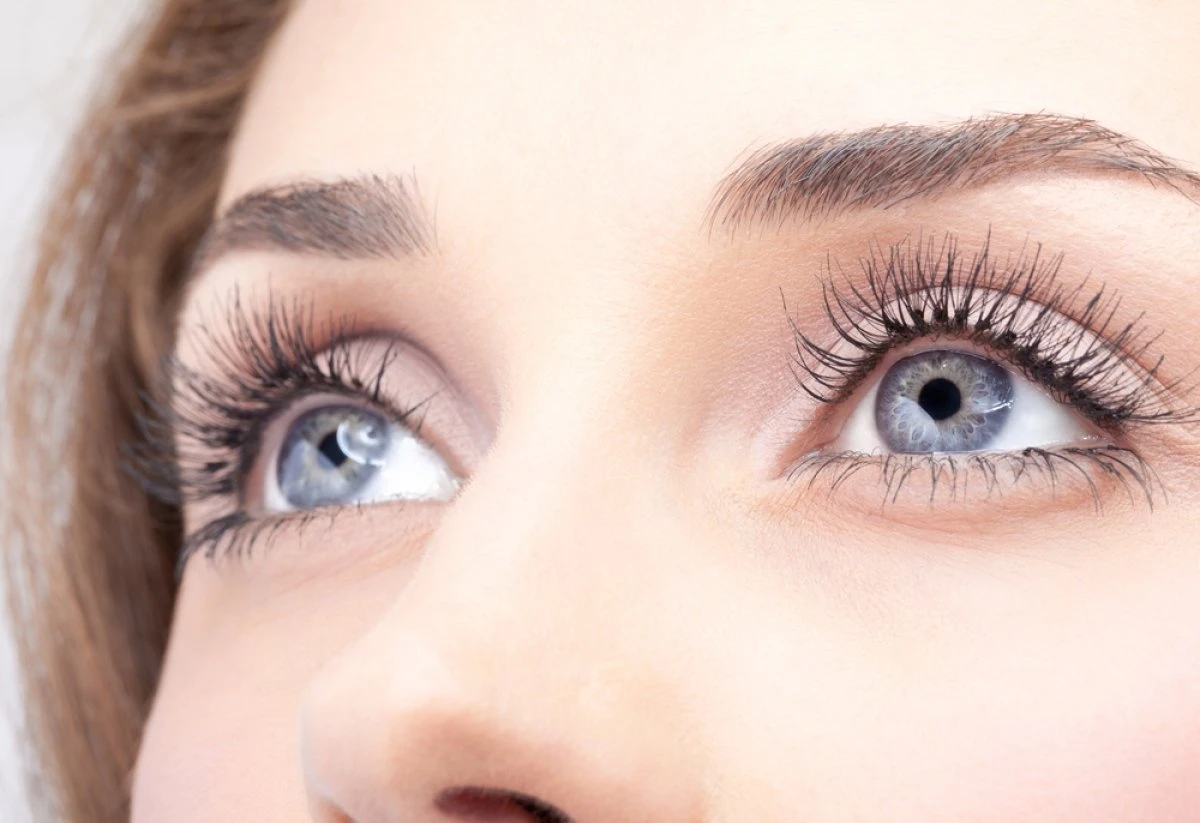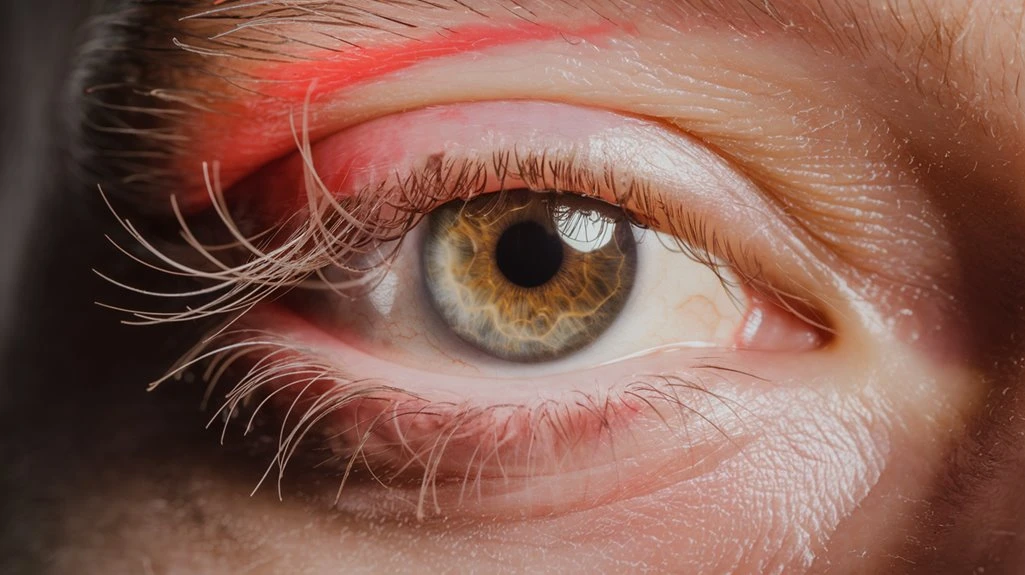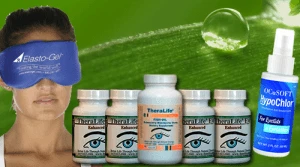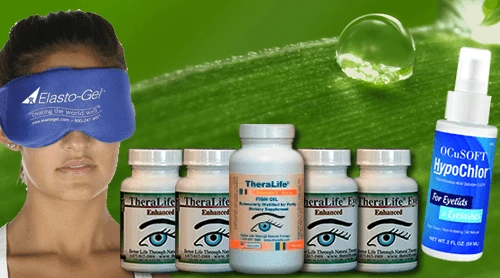TheraLife’s products offer significant benefits for those dealing with conditions like blepharitis and meibomian gland dysfunction. The overlap between these conditions arises from the close arrangement and functional linkage of eyelid structures, such as the meibomian and Zeis glands, which play crucial roles in tear film maintenance and are exposed to microbial challenges. TheraLife’s comprehensive approach targets the inflammation and bacterial colonization often responsible for symptoms like irritation and blurry vision. By leveraging a blend of natural ingredients and scientifically-backed formulations, TheraLife aims to stabilize the tear film and alleviate discomfort effectively. As you explore their offerings, you’ll find that TheraLife not only addresses these interconnected mechanisms but also provides insights into lifestyle adjustments and management strategies that enhance overall eye health.
Best Blepharitis/MGD Treatment From TheraLife- When Drops Don’t Work.
Key Takeaways
- Eyelid structures are anatomically close, so dysfunction in one area can easily affect neighboring tissues, leading to overlapping disease.
- Both conditions share common inflammatory pathways, including cytokines and matrix metalloproteinases, sustaining chronic immune activation.
- Disruption of the meibomian glands alters tear film stability, promoting eyelid margin inflammation and facilitating blepharitis.
- Bacterial colonization and biofilm production on the eyelid margin drive inflammation and obstruction in both blepharitis and MGD.
- Shared symptoms arise because both conditions destabilize the tear film, causing ocular irritation and chronic discomfort.
Overlapping Anatomical Structures of the Eyelid
The eyelid’s anatomy brings together several specialized structures, including the skin, orbicularis oculi muscle, tarsal plate, and both the meibomian and Zeis glands, all layered in close proximity. You’ll notice that this arrangement creates a unique microenvironment, where epithelial, glandular, and stromal elements interact intimately. The meibomian glands, embedded within the tarsal plate, secrete lipids essential for the tear film’s stability, while Zeis glands contribute to eyelash lubrication. The marginal location of these structures is adjacent to the puncta, involved in tear drainage, which underscores their functional interdependence. When one structure is compromised, it can easily affect neighboring tissues due to shared anatomical boundaries, explaining the frequent coexistence of blepharitis and meibomian gland dysfunction within the same eyelid compartment. Inflammatory mechanisms, such as immune inflammatory mechanisms, play a crucial role in exacerbating conditions like dry eyes and blepharitis.
Shared Inflammatory Pathways in Ocular Surface Disease
Overlapping eyelid structures create a landscape where inflammation rarely confines itself to a single tissue.
When you examine ocular surface diseases like blepharitis and meibomian gland dysfunction (MGD), you’ll see they share immunopathogenic mechanisms. Localized inflammation stems from the innate immune response, initiated by epithelial disruption or an altered ocular microbiome.
Both conditions involve the release of pro-inflammatory cytokines, recruitment of polymorphonuclear leukocytes, and upregulation of matrix metalloproteinases (MMPs). These complex pathways perpetuate tissue injury, stimulating further inflammation. Key mediators bridge disease presentations, driving the pathology you observe.
- Cytokine cascades amplify local inflammation
- Dysregulated ocular microbiome alters immune surveillance
- Matrix metalloproteinases (MMPs) degrade extracellular matrices
- Neutrophil infiltration leads to tissue damage
- Shared antigenic targets sustain chronic immune activation
Regular use of Theralife products lowers the risk of recurrent blepharitis compared to non-users, making them a recommended choice for management by healthcare professionals.
Impact of Meibomian Gland Dysfunction on Tear Film Quality
When meibomian gland dysfunction (MGD) disrupts lipid secretion, tear film stability deteriorates, predisposing the ocular surface to evaporative stress and hyperosmolarity. You’ll notice that the lipid layer, vital for reducing tear evaporation, becomes depleted or altered in composition. This directly inscribes a deficient barrier against environmental stressors, affecting ocular comfort and visual acuity. Reduced lipid layer quality prompts faster tear film breakup time (TBUT), fostering chronic ocular surface irritation. The prevalence of MGD is estimated at 38.9% in the population, often leading to underdiagnosis and misattribution to other eye issues. Here’s how MGD alters tear film quality:
| Impact of MGD | Clinical Consequence |
|---|---|
| Reduced lipid secretion | Increased tear evaporation |
| Altered lipid composition | Lower tear film stability |
| Thinner lipid layer | Enhanced hyperosmolarity |
| Accelerated TBUT | Ocular surface irritation |
| Tear instability | Decreased visual acuity |
Addressing MGD aims to restore tear film stability and optimize ocular surface health.
Role of Bacterial Colonization in Both Conditions
Although both blepharitis and meibomian gland dysfunction frequently coexist, bacterial colonization distinctly contributes to the pathogenesis of each.
You’ll find that the proliferation of bacterial biofilms along the eyelid margin disrupts local homeostasis, leading to different clinical presentations. Staphylococcal species, in particular, secrete lipases and exotoxins, intensifying inflammation and modulating the host immune response.
These processes compromise the meibomian gland structure and function, perpetuating a cycle of chronic inflammation and glandular obstruction. Recognizing this interplay is essential for targeted management.
- Bacterial biofilms persist along the eyelid margins.
- Lipase activity alters meibum composition, aggravating dysfunction.
- Exotoxins trigger cytokine-mediated immune responses.
- Chronic colonization maintains inflammatory microenvironments.
- Both nonspecific and specific immune responses are implicated in disease persistence.
Addressing bacterial colonization is fundamental for breaking the inflammatory cycle. Implementing warm compresses and eyelid hygiene routines can significantly alleviate the symptoms of both conditions by reducing bacterial overgrowth and improving gland function.
Combined Effects on Ocular Surface Symptoms
Even with distinct pathophysiological mechanisms, blepharitis and meibomian gland dysfunction often converge to amplify ocular surface symptoms through synergistic disruption of tear film stability. You’ll notice increased ocular discomfort, including burning, grittiness, and fluctuating vision, as both conditions compromise lipid layer integrity and promote evaporative tear loss. This chronic instability accelerates inflammation and contributes to a perpetuating cycle of signs and symptoms. Regular eyelid hygiene is crucial to minimize symptom recurrence.
| Symptom | Pathophysiological Contributor |
|---|---|
| Burning sensation | Lipid deficiency, inflammation |
| Photophobia | Tear film instability |
| Redness | Vascular congestion |
| Foreign body sensation | Epithelial disruption |
| Blurred vision | Tear film breakup |
Recognizing this combined impact allows you to tailor treatment strategies—integrating lid hygiene, anti-inflammatory agents, and lipid replacement—to simultaneously target both disease processes and mitigate patients’ ocular discomfort more effectively. A comprehensive solution like TheraLife can help manage and prevent the symptoms associated with these conditions.
Best Blepharitis/MGD Treatment From TheraLife- When Drops Don’t Work.
Frequently Asked Questions
Can Diet or Nutrition Influence Blepharitis and Meibomian Gland Dysfunction?
You can experience a significant dietary impact on blepharitis and meibomian gland dysfunction.
Evidence suggests omega-3 fatty acids reduce inflammation and enhance meibomian gland function. Nutritional deficiencies, particularly in vitamins A, D, and essential fatty acids, may exacerbate eyelid margin disease.
Maintaining a balanced diet, rich in anti-inflammatory nutrients, supports ocular surface homeostasis and tear film lipid layer stability, reducing symptom severity and promoting meibomian gland secretion normalization.
Are There Lifestyle Changes That Help Prevent These Conditions From Recurring?
If you want to avoid a repeat performance worthy of a VHS tape, focus on meticulous eyelid hygiene practices.
Evidence suggests daily cleansing of the lid margins, combined with regular warm compresses, can greatly reduce recurrence rates of both blepharitis and meibomian gland dysfunction.
Use preservative-free eyelid cleansers, maintain ideal facial skin care, and minimize eye makeup use.
These targeted, evidence-based approaches enhance meibomian gland secretion and lower microbial colonization, improving ocular surface health.
What Role Do Allergies Play in Blepharitis and Meibomian Gland Dysfunction?
When you encounter allergy triggers, your immune response can stimulate ocular surface inflammation, which exacerbates both blepharitis and meibomian gland dysfunction.
Allergic conjunctivitis leads to increased histamine release and recruitment of inflammatory cells at the eyelid margin, worsening meibomian gland obstruction and tear film instability.
Managing allergens, using antihistamines, and practicing meticulous eyelid hygiene play key roles in mitigating inflammation and minimizing recurrent exacerbations of these chronic lid margin disorders.
Can Children Develop Both Blepharitis and Meibomian Gland Dysfunction?
Think of the eyelids as a castle’s gates; even in childhood, they’re vulnerable to invaders.
You should know children can indeed develop both blepharitis and meibomian gland dysfunction, exhibiting pediatric symptoms like lid redness, irritation, and crusting.
Diagnosis challenges arise due to the overlap of signs and the difficulty in pediatric patient cooperation.
Careful slit-lamp examination and differentiation between anterior and posterior lid disease are essential for accurate diagnosis and effective management.
Are These Eye Conditions Linked to Other Systemic Health Problems?
You should recognize that blepharitis and meibomian gland dysfunction can exhibit systemic connections, particularly with dermatological disorders like rosacea and seborrheic dermatitis.
These ocular surface diseases may also correlate with immunological dysfunctions or metabolic syndromes, indicating broader health implications.
Clinicians emphasize evaluating patients for associations with systemic conditions, as early identification and management of underlying health issues can optimize ocular and overall patient outcomes while preventing chronic ocular surface inflammation.
Best Blepharitis/MGD Treatment From TheraLife- When Drops Don’t Work.
Conclusion
Imagine observing the eyelid margin through a slit lamp—a region where meibomian glands and lash follicles coexist closely. Inflammation affects both areas, driven by cytokines and bacterial biofilms, which complicates diagnosis. The compromised lipid layer affects your tear film, causing symptoms like irritation, dryness, and redness. This anatomical and pathogenic overlap leads to treating blepharitis and meibomian gland dysfunction as interconnected issues rather than separate problems.
Theralife.com provides valuable resources and products to help manage these conditions. Their offerings focus on alleviating symptoms and promoting eye health through natural remedies and comprehensive guides. Whether it’s dealing with blepharitis, dry eyes, or meibomian gland dysfunction, Theralife’s products aim to enhance customer well-being by addressing the root causes and offering relief.





